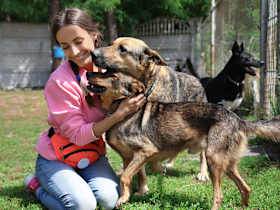10 Red Flags Every Pet Parent Should Know Before Adopting a Dog
Want to ensure your dog adoption goes smoothly? Keep watch for these common red flags.
Want to ensure your dog adoption goes smoothly? Keep watch for these common red flags.
by Katie Koschalk, | February 18, 2025

Christine La / Stocksy
Before you adopt a dog, it’s crucial to be aware: not everyone claiming to rescue animals has their best interests at heart. Some operate for-profit puppy mills, masquerading as responsible rescues. These mills push harmful myths and do a disservice to all the hardworking animal rescues committed to responsible practices. Recognizing red flags — such as everything from high-pressure tactics to questionable payment practices — can guide you toward responsible, ethical animal rescues and avoid adoption scams.
Adopting a dog is one of the most impactful ways to support animal welfare and offer a home to a pet in need, but only when done through a legitimate organization. Here’s what you need to know.
No single red flag guarantees a scam or unethical rescue, but if you spot multiple warning signs, it’s best to walk away. Here are key warning signs to watch for.
Transparency is crucial in any adoption. A reputable animal rescue should be willing to explain every part of the adoption process, from how to fill out the application to how to get after-adoption support.
Puppy mills and unethical sellers are often vague or evasive about aspects of the adoption process. An ethical organization values clarity and communication, and a lack of either can indicate they may be hiding questionable practices.
Adopting a dog is a significant, life-altering decision that requires careful consideration. Trustworthy rescues respect this and give potential adopters the time and space they need to make an informed choice.
If an individual or organization is overly pushy, using guilt tactics or suggesting you “decide now or lose out,” it may indicate they’re more focused on the speed of transactions (or receiving the associated “adoption” fee) than the quality of matches.
An ethical rescue will understand that you want to know as much as possible about the dog before bringing them home. They will provide as much detail as possible about the dog’s medical history, behavior, and care needs, though they may not always have complete records, especially for strays.
In contrast, scammers or disreputable sources often give vague or unrealistic answers, avoid questions, or make inconsistent claims about a pet’s health, age, or background. Trustworthy organizations are transparent about what they do and don’t know, focusing on setting up both you and the dog for success.
An adoption fee is standard when adopting a dog from a rescue, generally ranging from $100 to $800, but there are no hard and fast rules, and fees can vary widely. Use caution with unfamiliar organizations, as extremely low prices — especially for a purebred dog — may indicate a scam involving unhealthy animals or deceptive fees. At the same time, overly high fees for a young puppy might suggest that it is, in fact, a for-profit puppy breeder.
Additionally, if an organization requires upfront payments, insists on cash-only transactions, or avoids issuing receipts, this could signal a potential scam. These practices increase the risk of losing your money without receiving a dog in return.
“It’s important that everyone in the home meets and spends time with the dog being considered for adoption,” says Kara Starzyk, the shelter manager at Abandoned Pet Rescue. “Walking or playing with the pet allows you to feel if there’s a connection and will give you insight into the pet’s personality. But keep in mind that it could take weeks or months for the pet to learn your routine and truly feel at home,” she explains.
If an organization won’t allow an in-person meeting, this may suggest they’re not being transparent about the dog’s behavior or condition, or that this is an outright scam. Ethical rescues understand the importance of this interaction and encourage meet-and-greet sessions to help find the right fit for everyone involved.
“All reputable animal welfare organizations should provide the animals with veterinary care, nutritious meals, enrichment, and a clean environment,” Starzyk says. If you see unsafe conditions or signs of neglect, it might reflect a lack of adequate resources or care for the animals.
Be cautious of organizations that refuse to let you see where the animals are housed. Facilities should demonstrate they’re well-equipped to provide for the dogs they house, both physically and emotionally.
Rescues committed to animal welfare address any medical needs a dog may have before putting them up for adoption. If a dog has untreated health issues, such as skin infections or visible injuries, this could signal a lack of investment in the animal’s well-being. If the organization is reluctant to provide treatment records or seems unconcerned about a dog’s health, they probably aren’t prioritizing proper care for the animals.
Some rescue dogs may have behavioral challenges due to past trauma or anxiety. If the organization dismisses or downplays behavioral concerns without giving you a realistic understanding of the dog’s needs, this could lead to challenges that impact the dog’s well-being and your experience as a pet parent.
Although many behavioral issues can be overcome, honest organizations want adopters to be prepared for the commitment required and set up everyone for success.
Sometimes, even with the best intentions, an adoption doesn’t work out. Ethical rescues recognize this and allow you to return the dog, if necessary.
If an organization refuses to consider taking back the dog under any circumstances, this can be a red flag indicating they may prioritize placing animals in homes quickly, rather than finding them a long-term family. A responsible rescue understands the importance of post-adoption support and will generally have a return policy for these cases.
If you need additional support finding a new home for your dog, consider using Adopt a Pet’s Rehome platform.
Many reputable rescues will be registered as 501(c)(3) charities, which means they are nonprofit organizations that are exempt from federal taxes. You can verify an organization’s nonprofit status by checking charitynavigator.org or the BBB Wise Giving Alliance.
It’s crucial to stay alert for red flags when adopting a pet to avoid being taken advantage of, or inadvertently supporting unethical people or organizations. However, it’s equally important to remember the animals in their care. By reporting your concerns responsibly, you can help protect the animals, as well as yourself and others.
If you suspect a pet adoption scam, you can report it to:
The Federal Trade Commission (FTC) at their website or by calling 877-FTC-Help.
The Better Business Bureau (BBB) website. You can also look up scams on the BBB website.
Your local law enforcement.
“Animal rescues may have adoption counselors who know the pet’s temperament and history, so they can help match adopters to a pet that best fits their lifestyle and family,” Starzyk says. Here are some factors to consider before welcoming a dog into your home.
Age: Puppies are full of energy and require plenty of training, while adult dogs are often more settled and may already know basic commands. Senior dogs, although calmer, may need special medical care. Consider which age range aligns best with your lifestyle and expectations.
Energy level: Some dogs are high-energy and need lots of exercise and engagement, while others are naturally more relaxed. Be realistic about your ability to provide the physical and mental stimulation your chosen dog might need.
Compatibility with family members: Consider who else lives in your household, including children, elderly family members, or other pets. Some dogs are naturally more compatible with others, while some may feel uncomfortable in bustling environments or around other animals.
Grooming needs: Some dogs, particularly those with long hair or double coats, have more grooming needs that can be costly and time-consuming.
Financial investments: Dogs come with ongoing costs, including food, routine and emergency veterinary care, grooming, training, and pet insurance. Be ready to commit to the financial responsibility of dog ownership, especially because some popular dog breeds may have specific health needs that could increase costs.
Time commitment: Dogs need daily interaction, exercise, training, and attention, which can be a significant time commitment. If you have a busy schedule or travel frequently, consider whether or not you can provide the consistency and care a dog requires.
Adopting a dog is a significant, long-term commitment that means caring for a living being for many years — potentially more than a decade. Instead of rushing into a decision, take the time to think about the type of dog who would fit your lifestyle best, or whether now is truly the right time to bring a dog into your life.
Avoid adopting from organizations or individuals that aren’t transparent, apply high-pressure tactics, or don’t allow meet-and-greets. Also, be cautious of organizations with poor facilities or unreasonably high fees.
The 3-3-3 rule refers to a dog’s adjustment timeline: three days to decompress, three weeks to settle in, and three months to fully bond and feel comfortable in their new home.
Yes, adopting from reputable shelters is safe. These organizations prioritize health checks and transparency, and take good care of the dogs they’re housing.
One of the most common mistakes adopters make when applying for adoption is rushing the decision. They may not consider a pet’s compatibility with their lifestyle, the dog’s energy levels, and the fact that this is a long-term commitment. Research and patience are key.
Reputable rescues are transparent, encourage questions, have clean facilities, and prioritize matching dogs to compatible homes. They offer post-adoption support and have clear, reasonable adoption fees.
Adoption applications may be denied if the rescue determines a mismatch between the dog’s needs and your lifestyle, such as work hours, experience level, or home environment. Sometimes, high demand for specific dogs also leads to limited availability.
Gopalan, Nisha. “Why You Should Not Get a Puppy on Craigslist.” Kinship.com, 2023, www.kinship.com/dog-lifestyle/craigslist-puppy-scams..
Humane World for Animals. “Adopting from an Animal Shelter or Rescue Group.” Humane World for Animals, 2018, www.humaneworld.org/en/resources/adopting-animal-shelter-or-rescue-group.
Reisen, Jan, et al. “How to Choose the Right Dog Rescue Group.” American Kennel Club, Nov 08, www.akc.org/expert-advice/advice/how-to-choose-the-right-rescue-group.
“Stopping Puppy Mills.” Humane World for Animals, 2023, www.humaneworld.org/en/issue/stopping-puppy-mills.

Katie Koschalk is a freelance writer based in Northern California. Fusing her love and knowledge of animals with her journalism degree and years of professional writing, Katie is dedicated to improving the lives of pets and their caretakers by sharing helpful and accurate information. When she’s not at her desk, you can find her exploring trails with her Aussie, Hunter, cooking plant-based meals, and talking to her two cats, Jax and Sadie, in really ridiculous voices.

Shelters & Rescue

Shelters & Rescue

Shelters & Rescue

Shelters & Rescue
Read on for the grim statistics and hopeful solutions to this national problem plaguing shelters and rescues alike

Shelters & Rescue
Shelters always need a variety of volunteers — and you offer more helpful skills than you realize.

Adoption Advice
The reality is, it costs a lot of money to care for shelter animals and to keep a shelter clean and safe. Find out what you can expect to pay when bringing a new pet home.

Foster & Volunteer
Shelters need help, especially during the holiday season. From donating supplies or your time, here are the many ways you can pitch in.

Rehome
Found a stray cat? Follow these steps to ensure their well-being while you search for their people.

Foster & Volunteer
Thinking about fostering a pet? Read more to learn about the fostering process and benefits of fostering.